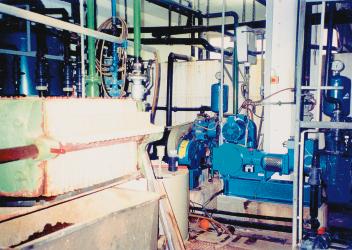A company like the gardening equipment specialist Gardena, which understands how close its customers feel to nature, naturally places importance on innovation and careful use of resources in its own production facilities. This applies to the waste water treatment plant at its Niederstotzingen works, for example. The waste water is carefully treated to maximise the volume of service water that can be returned to the plant.
During waste water treatment, water containing solid and suspended matter is collected in two large reservoirs. After neutralisation, an Abel hydraulic membrane pump feeds this thin slurry to a chamber filter press, where the water is removed. The filtrate flows back to the treatment system for reuse, while the dewatered sludge cake is disposed of externally.
As in many waste water treatment plants, the thin slurry to be treated is not always of the same consistency, since the composition varies for each stage of production: the sludge may contain few or very many abrasive components, the consistency ranges from thin to thick-flowing and there can also be different proportions of foam in the thin slurry due to the treatment. Plug-like masses may escape from the storage reservoirs as well. This situation demands a robust feed pump that can handle all such fluctuations and irregularities reliably and without failing.
Running costs decide the issue
Gardena has been using Abel pumps for many years. In 1968, an SKZ 401 with a maximum pumping capacity of 1.5 m³/h was installed. This was followed (in 1989) by an FFG 251–11/3 with a maximum pumping capacity of 2.5 m³/h. The older pump was kept in reserve to handle particularly large volumes of thin slurry. Gardena recently decided to install an even more powerful pump and to send the ancient SKZ 401 into well-earned retirement.
It was not easy to choose the right replacement. On the one hand, Gardena was very happy with its Abel pumps but on the other hand, the firm wanted to minimise investment costs and was therefore very keen on the idea of an air driven membrane pump. It was a comparison of the running costs (power consumption) of air-driven pumps and the hydraulic membrane pumps in the Abel HM series that prompted the decision to opt for the latter. In the end, the very low power consumption was the scale-tipping factor. Although air driven membrane pumps are cheaper to buy, the extremely large volumes of air and the cost per m³ of compressed air can add up to startlingly high expenditure. For Gardena, the cost of compressed air would have been 10 times the cost of power for a piston membrane pump. The slightly higher investment in this pump can thus be paid off much faster. The powerful electric drive moreover guarantees much shorter filter pressing times compared to the compressed air drive, which becomes increasingly weaker as the pressure rises.
Gardena thus plumped for a hydraulic membrane pump in the HM series. This pump series is available as a single-acting piston membrane pump (HMS) for lower flow rates or as a double-acting pump (HMD) for higher flow rates. The special feature of the series is that HM pumps are equipped with a newly designed, preformed membrane and a mechanical (pressure-compensated) membrane positioning control. If the optimum end positions are selected, the membrane positioning control prevents the membrane being exposed to pressure peaks during the suction and discharge strokes. As with all piston membrane pumps, the HM series is self-priming and can be run dry safely. The pumps are very efficient and offer quiet running as well as high availability.
Other important technical features of the HM series:
- The hydraulic side is equipped with tested safety valves to prevent the maximum permitted pressure being exceeded.
- The product side is equipped with a preformed membrane that is matched to the operating conditions.
- The drive side, which consists of a re-ducing and an eccentric gear, guarantees optimum power transmission, even at low speeds.
- The use of a frequency converter greatly reduces energy costs – a particular advantage when the pump is used with a filter press.
Gardena opted for an HMS-G-12–0060 with a maximum pumping capacity of 5 m³/h. The company also achieved a further significant reduction in the energy costs for feeding the filter press by using a programmable frequency converter (VFD) to control the motor speed. As the pressure rises in the filter press, the VFD reduces the flow rate by adjusting the motor speed – a lower speed means less power is consumed and therefore less expenditure on energy.
cpp 439
Share:







